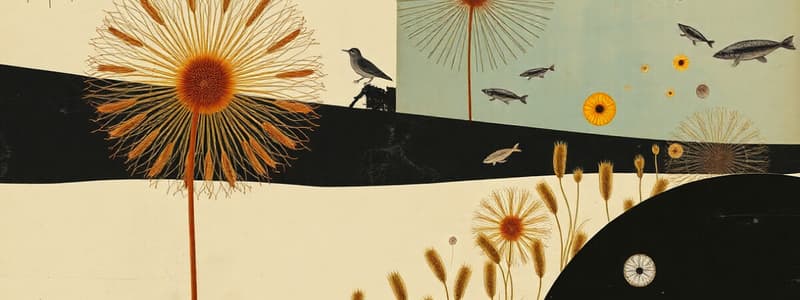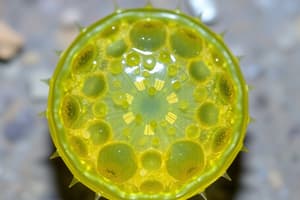Podcast
Questions and Answers
What best describes the nutrition mode of Euglenoids in the absence of sunlight?
What best describes the nutrition mode of Euglenoids in the absence of sunlight?
- Heterotrophic (correct)
- Saprophytic
- Autotrophic
- Parasitic
Which characteristic differentiates diatoms from dinoflagellates?
Which characteristic differentiates diatoms from dinoflagellates?
- Presence of silica in cell walls (correct)
- Color variation depending on pigments
- Ability to form red tides
- Two flagella arrangement
Which of the following is a primary feature of slime moulds?
Which of the following is a primary feature of slime moulds?
- Chitinous cell walls
- Formation of a plasmodium (correct)
- Photosynthetic capabilities
- Presence of yellow pigments
What is the main ecological role of diatoms in marine environments?
What is the main ecological role of diatoms in marine environments?
What distinguishes dinoflagellates in terms of visual characteristics?
What distinguishes dinoflagellates in terms of visual characteristics?
Which statement about euglenoids is incorrect?
Which statement about euglenoids is incorrect?
What is the composition of the cell wall in diatoms that makes it indestructible?
What is the composition of the cell wall in diatoms that makes it indestructible?
In what way do slime moulds ingest food?
In what way do slime moulds ingest food?
Which pigment-related feature is common among euglenoids?
Which pigment-related feature is common among euglenoids?
What characteristic of dinoflagellates may pose a risk to marine ecosystems?
What characteristic of dinoflagellates may pose a risk to marine ecosystems?
Study Notes
Chrysophytes
- Comprising diatoms and golden algae (desmids), found in both fresh and marine waters.
- Microscopic organisms that float passively in water currents as plankton.
- Most are photosynthetic, utilizing sunlight to produce energy.
- Diatoms possess unique cell walls consisting of two overlapping shells that fit together like soap boxes.
- Walls are made of silica, rendering them indestructible and capable of leaving significant deposits, known as 'diatomaceous earth', over billions of years.
- Diatomaceous earth is gritty and utilized in polishing and filtration processes.
- Diatoms are primary producers in oceanic ecosystems.
Dinoflagellates
- Primarily marine and photosynthetic organisms found in diverse colors: yellow, green, brown, blue, or red, based on cellular pigments.
- Possess a cell wall reinforced with stiff cellulose plates.
- Typically have two flagella; one longitudinal and the other transverse, situated in a furrow between wall plates.
- Red dinoflagellates, such as Gonyaulax, can proliferate rapidly, causing "red tides."
- Toxins from large populations during red tides can be lethally harmful to marine life, including fish.
Euglenoids
- Mostly freshwater organisms, commonly inhabiting stagnant water environments.
- Feature a flexible protein-rich layer known as pellicle instead of a traditional cell wall.
- Possess two flagella: one short and one long.
- Photosynthetic in sunlight; in the absence of light, they behave as heterotrophs, preying on smaller organisms.
- Pigments of Euglenoids are similar to those found in higher plants, exemplified by Euglena.
Slime Moulds
- Categorized as saprophytic protists, feeding on decaying organic matter.
- Bodies are motile, moving along decaying twigs and leaves while engulfing nutrients.
- Under favorable conditions, slime moulds can aggregate to form a plasmodium, which can grow several centimeters in diameter.
- The plasmodium is multinucleate and lacks a cell wall, enabling efficient nutrient absorption through phagocytosis.
- Spores produced by slime moulds can germinate into new individuals, continuing the life cycle.
Studying That Suits You
Use AI to generate personalized quizzes and flashcards to suit your learning preferences.
Description
This quiz explores the fascinating group of Chrysophytes, including diatoms and golden algae. Understand their habitats, characteristics, and roles in aquatic ecosystems. Test your knowledge on their structure and significance in both freshwater and marine environments.




